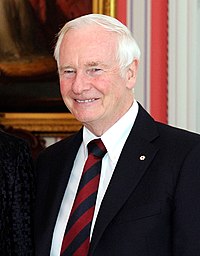Governor general of Canada
| Governor General of Canada | |
|---|---|

Badge
|
|
| Viceroy | |
| Style | His Excellency the Right Honourable |
| Residence |
Rideau Hall, Ottawa; La Citadelle, Quebec City |
| Appointer | Monarch of Canada |
| Term length | At Her Majesty's pleasure |
| Formation | 1 July 1867 |
| First holder | The Viscount Monck |
| Salary | $288,900 (CAD) |
| Website | www.gg.ca |
The Governor General of Canada (French [masculine]: Gouverneur général du Canada, or [feminine]: Gouverneure générale du Canada) is the federal viceregal representative of the Canadian monarch, currently Queen Elizabeth II. Because the person of the sovereign is shared equally both with the 15 other Commonwealth realms and the 10 provinces of Canada and resides predominantly in her oldest realm, the United Kingdom, she, on the advice of the Canadian prime minister, appoints the governor general to carry out most of her constitutional and ceremonial duties. The commission is for an unfixed period of time—known as serving at Her Majesty's pleasure—though five years is the normal convention. Beginning in 1959, it has also been traditional to rotate between anglophone and francophone incumbents. Once in office, the governor general maintains direct contact with the Queen, wherever she may be at the time.
The office began in the 16th and 17th centuries with the Crown-appointed governors of the French colony of Canada followed by the British governors of Canada in the 18th and 19th centuries. Subsequently, the office is, along with the Crown, the oldest continuous institution in Canada. The present incarnation of the office emerged with Canadian Confederation and the passing of the British North America Act, which defines the role of the governor general as "carrying on the Government of Canada on behalf and in the Name of the Queen, by whatever Title he is designated". Although the post initially still represented the government of the United Kingdom (that is, the monarch in his British council), the office was gradually Canadianized until, with the passage of the Statute of Westminster in 1931 and the establishment of a separate and uniquely Canadian monarchy, the governor general become the personal representative of the independently Canadian sovereign, the governor general became the direct, personal representative of the uniquely Canadian sovereign (the monarch in his Canadian council). Throughout this process of gradually increasing Canadian independence, the role of governor general took on additional responsibilities. For example, in 1904 the Militia Act granted the governor general the title of Commander-in-Chief of the Canadian militia on behalf of the sovereign in 1904, the Militia Act granted permission for the governor general to use the title of Commander-in-Chief of the Canadian militia, in the name of the sovereign and actual Commander-in-Chief, and in 1927 the first official international visit by a governor general was made. Finally, in 1947, King George VI issued letters patent allowing the viceroy to carry out almost all of the monarch's powers on his or her behalf. As a result, the day-to-day duties of the monarch are carried out by the governor general, although, as a matter of law, the governor general is not in the same constitutional position as the sovereign; the office itself does not independently possess any powers of the Royal Prerogative. In accordance with the Constitution Act, 1982, any constitutional amendment that affects the Crown, including the office of the Governor General, requires the unanimous consent of each provincial legislature as well as the federal parliament.
...
Wikipedia

